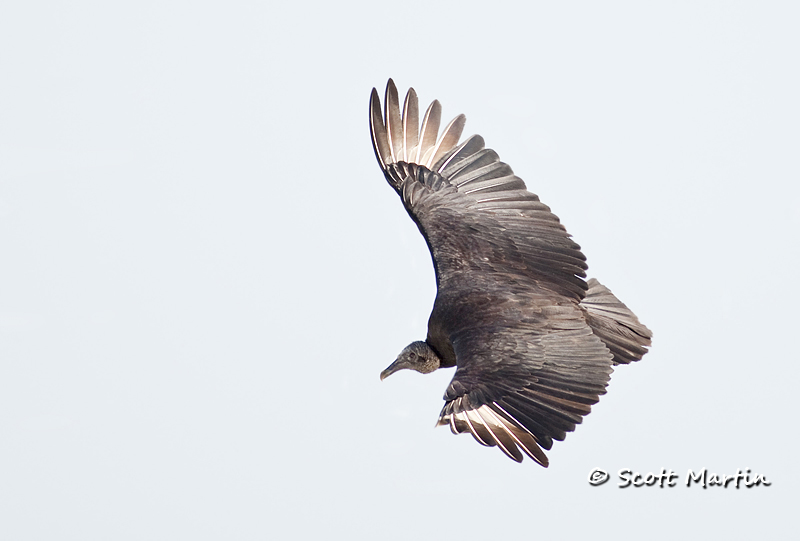
by Scott Martin Photography | Apr 19, 2011 | Birds, Blog, Raptors
Pretty much wherever you drive in the United States and the southern portions of Canada you will see vultures soaring overhead, with that characteristic wobble while gliding giving away their identity. If you are in the Northern States or Canada, you will probably be seeing the larger red-headed Turkey Vulture as the smaller and dark headed Black Vulture typically stays in the Southern & Eastern States. These two species are pretty much the only Vultures you will see in North America. The Turkey Vulture is the most common of the two and also enjoys the widest range with the global population estimated at 4,500,000. The Turkey Vulture is also known as a Buzzard.
Neither the Black Vulture or Turkey Vulture posses a syrinx (the vocal organ of birds) and therefore have no song to sing, resorting only to grunts and hisses which you will often hear when fighting over food. The two species of vulture are very similar with the Turkey Vulture being slightly larger than the Black Vulture. The most obvious difference between the two is head colour, red for the Buzzard and dark for the Black Vulture. A less obvious difference between the two is that the Turkey Vulture holds its wings in a slight ‘V’ formation while gliding where the Black Vulture holds its wings in a parallel position when soaring. While both types have superb visual acuity the sense of smell is much better in the Turkey Vulture which it uses to its advantage when looking for carrion, the primary food source for both vultures.
Vultures are species of birds we photographers often overlook, perhaps because we don’t have the opportunity to get close to them or perhaps it’s that they are not as glamorous as other birds, or even other scavengers like the Crested Caracara. Anyway, this winter I made the attempt to get some decent images of vultures and I trust you enjoy them. All of the Black Vulture images were taken at Cherie Beach which is on the Atlantic Coast of Florida just south of Cape Canaveral and were all shot using the Canon EF 400mm f/5.6 L lens. The image of the Turkey Vultures was taken from a boat in Lake Toho using the Canon EF 500mm f/4 L IS lens.
The 400/5.6 is probably the best lens available for in-flight shots because of its light weight, compact size and super fast auto-focus speed.

.
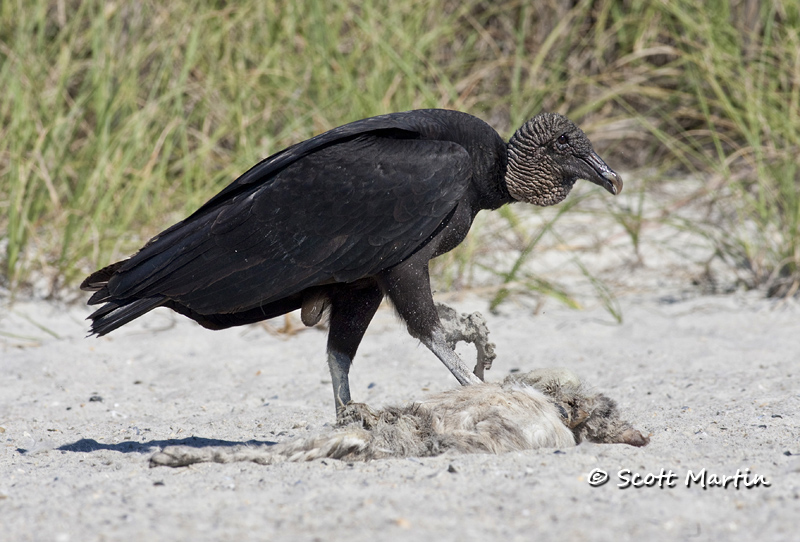
.
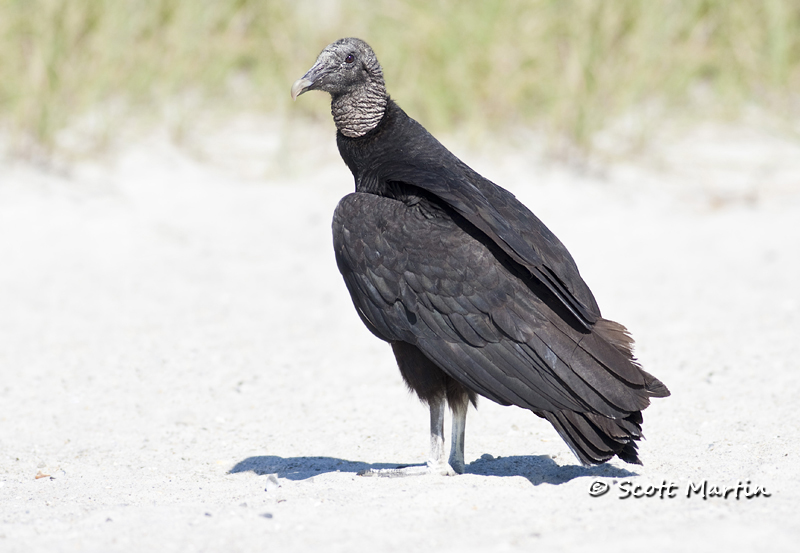
.
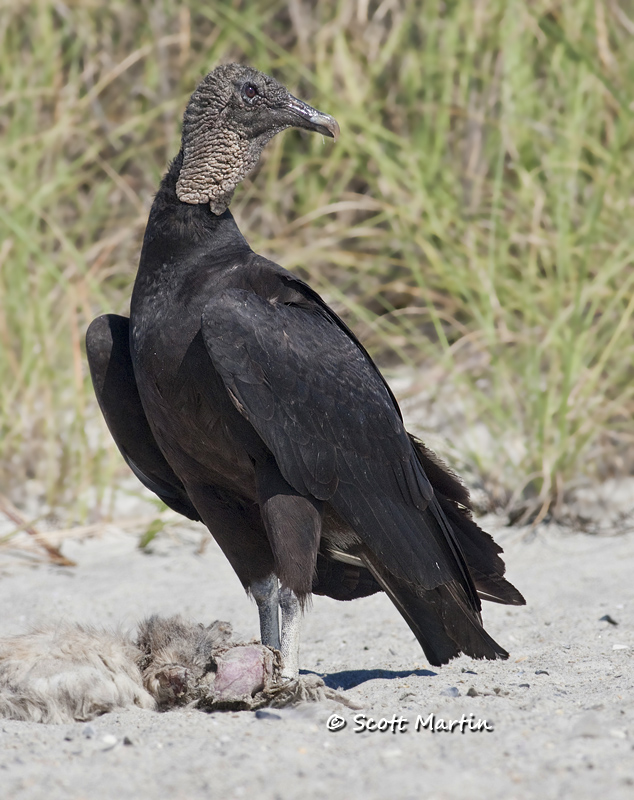
.
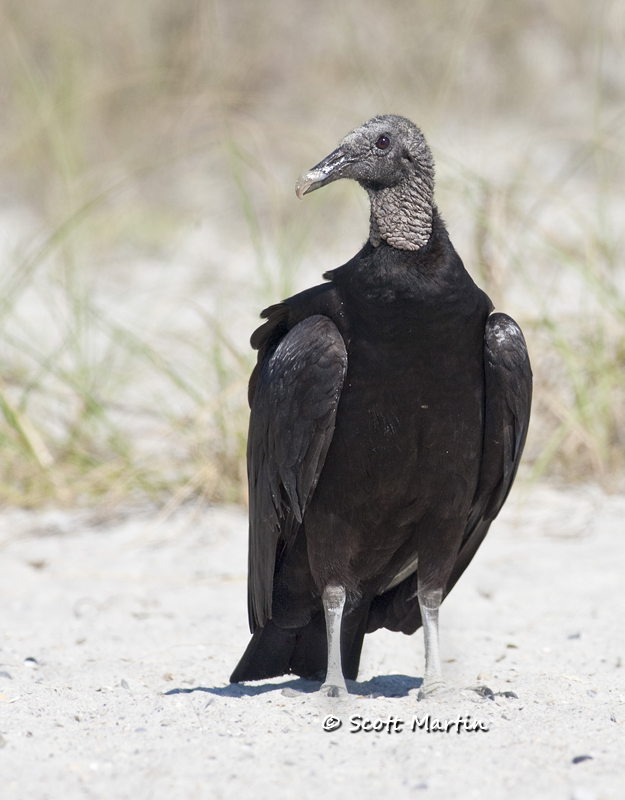
Two Turkey Vultures perched in a tree….this shot almost makes them look good 🙂
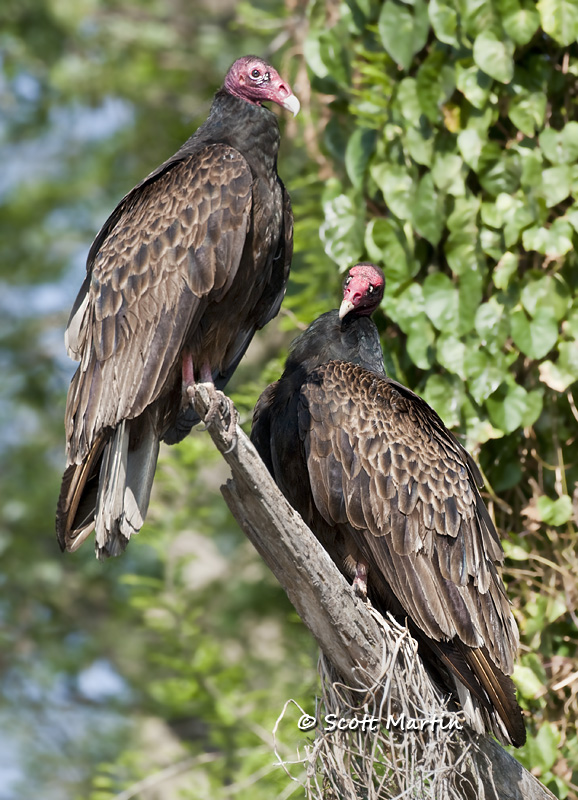
The last two images were taken a year ago at the Viera Wetlands and are of a Crested Caracara which I mentioned above as a better looking scavenger than the vultures. These images are unique as the Coot leg being taken back to the nest for the fledglings was not collected as scavenged carrion but rather the Coot was taken alive by the Caracara, a phenomenon I had not witnessed before as Caracara are primarily scavengers.
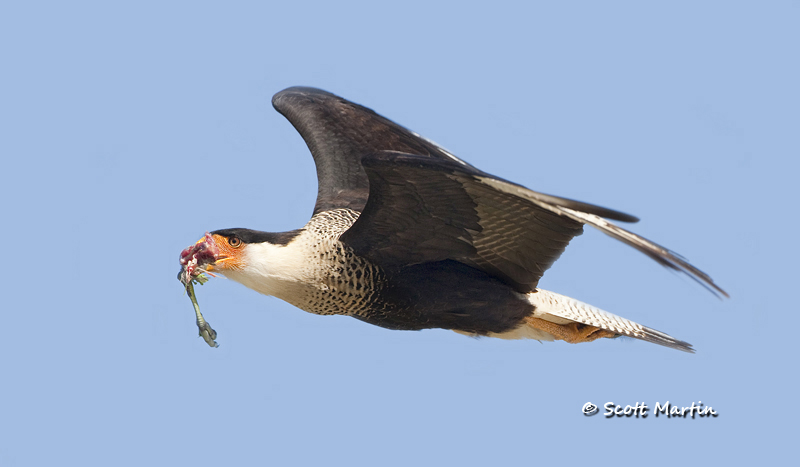
.
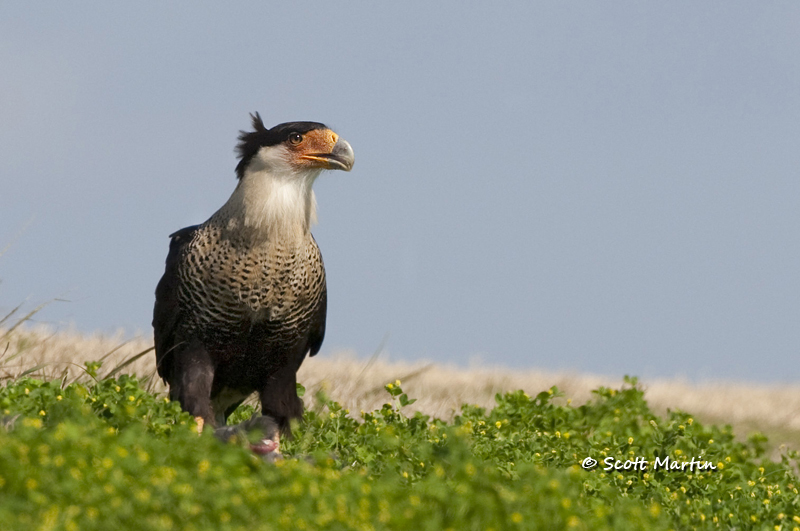
More images can be seen in the Vultures & Caracara Gallery
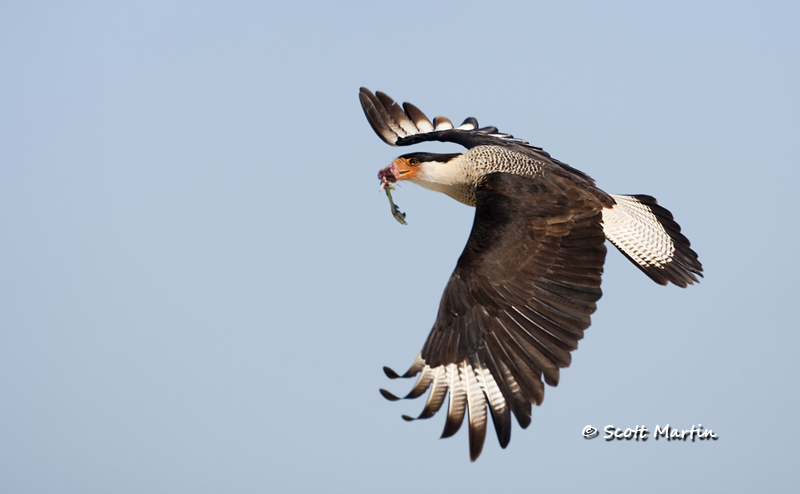
by Scott Martin Photography | Apr 16, 2011 | Birds, Blog, General
The Viera Wetlands are a series of water retention ponds that are part of the town of Viera’s waste management system. Viera is located on Florida’s Space Coast approximately 15 miles south of Cocoa Beach. The Wetlands provide the perfect environment for both resident and migratory birds with the variety of species present truly amazing. It’s common to photograph twenty to thirty species on a good day. Besides birds you can also count on seeing alligators and the odd snake as well. For a more complete description of the Viera Wetlands please follow this link.
Viera is also a great place to meet other birders and photographers who are always happy to point you towards a new bird or tell you about a rare migrant they’ve seen or photographed.
Besides the tremendous variety of birds present at Viera it is also a place where the birds seem quite used to the presence of people and will allow surprisingly close access, especially if you are patient. In terms of gear I’ve used everything from a 24-105, 70-200/2.8, 400/5.6 and 500/4 with a 1.4xTC for 700mm; so when heading to Viera bring everything you’ve got because you will probably be able to use it all!
The following images are some favourites taken at the Viera Wetlands over the past few years (all taken during the month of March when we vacation in Florida each year).
Crested Caracara

Osprey with fish
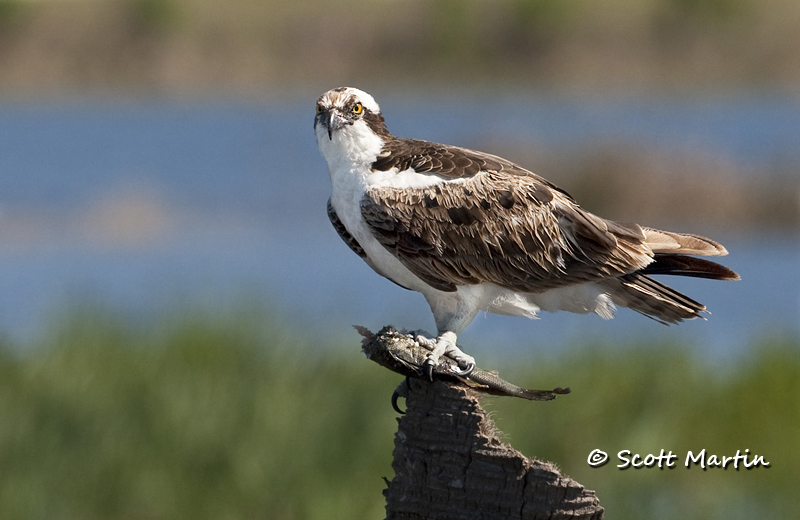
Limpkin
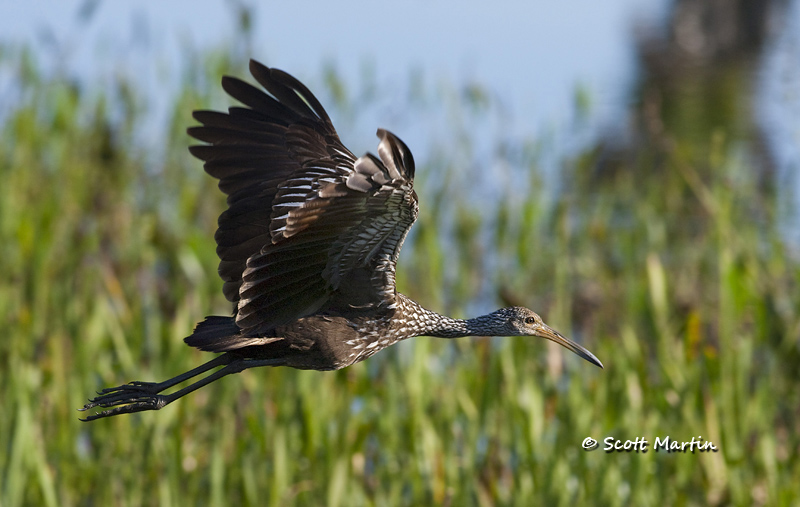
Cattle Egret
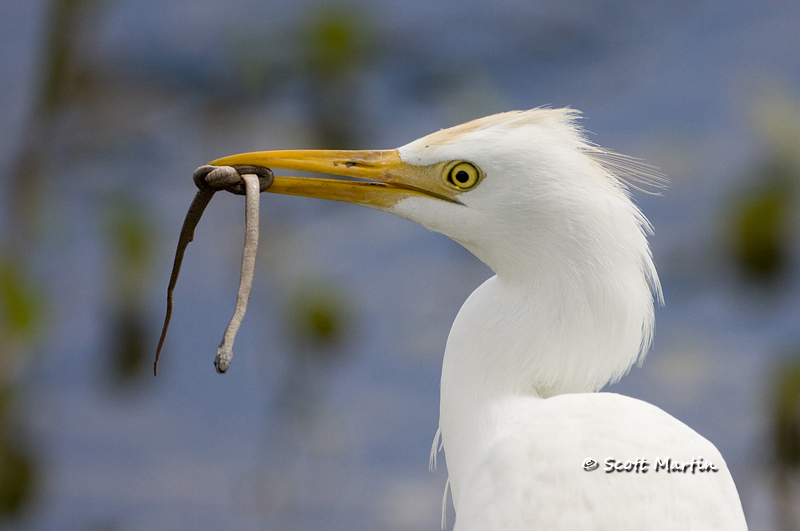
Least Bittern
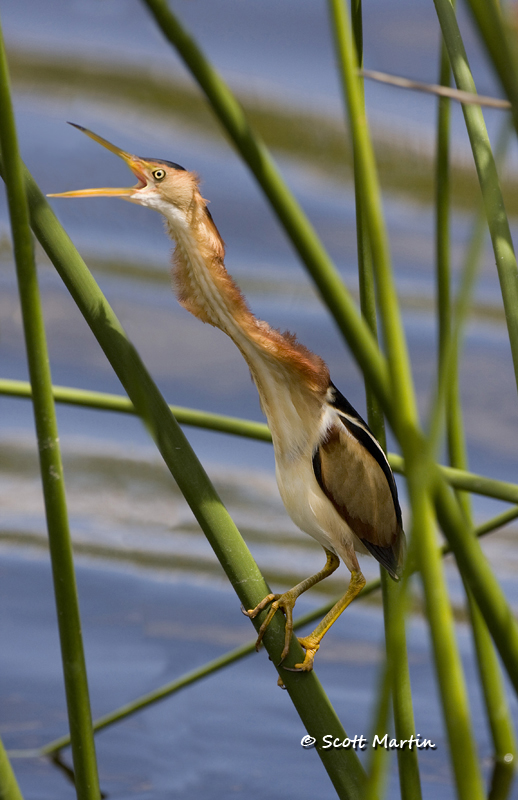
Northern Harrier
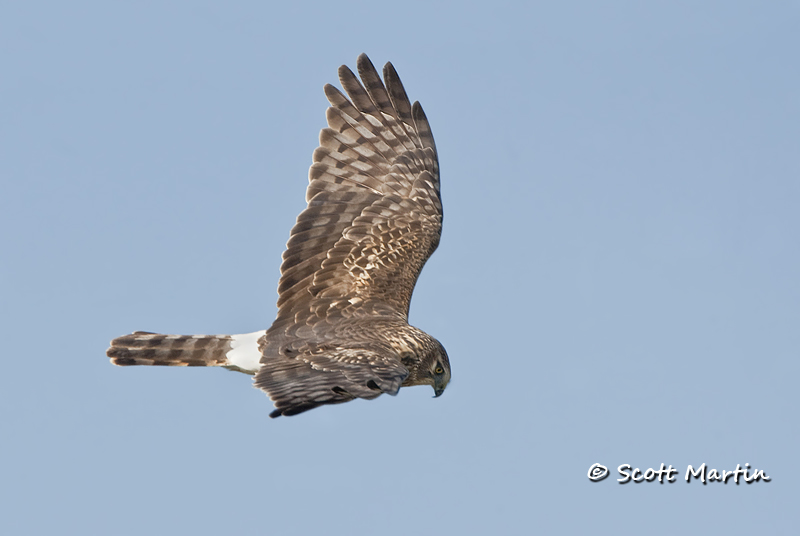
Blue Wing Teal
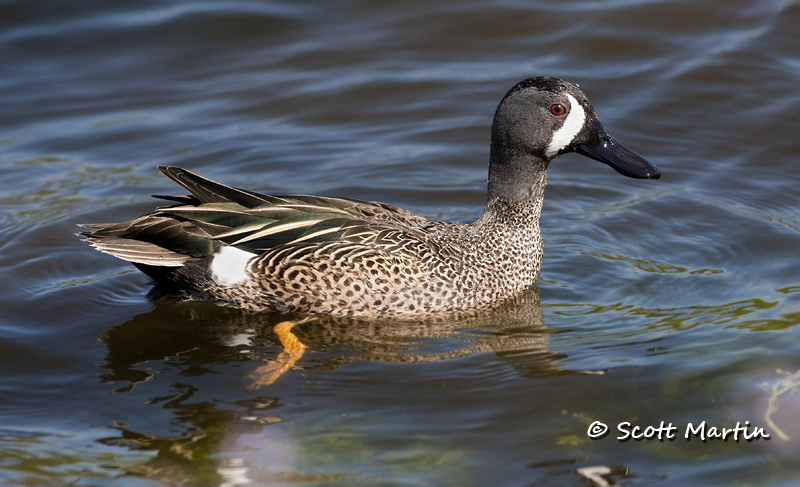
Ring Necked Duck (which is a new species for me, taken last month)
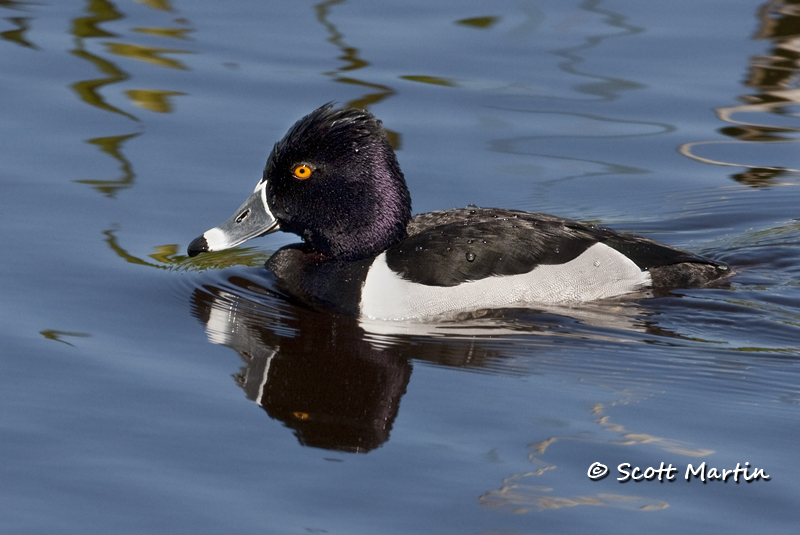
and the female
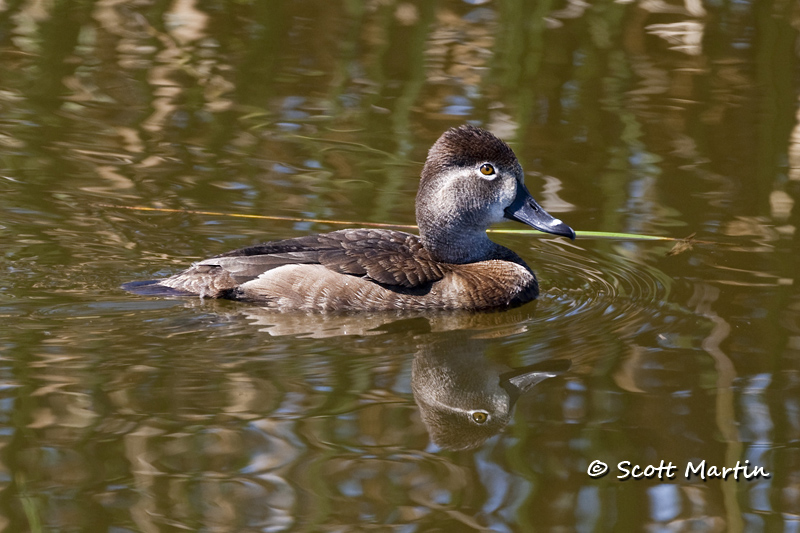
And finally here is one of those alligators I told you about. This is the first ‘gator I’d photographed and it was about eight feet long. As I was lying on the grass about fifteen feet away to take this full frame shot, it donned on me that it probably wasn’t a wise thing I was doing. Fortunately he wasn’t hungry.
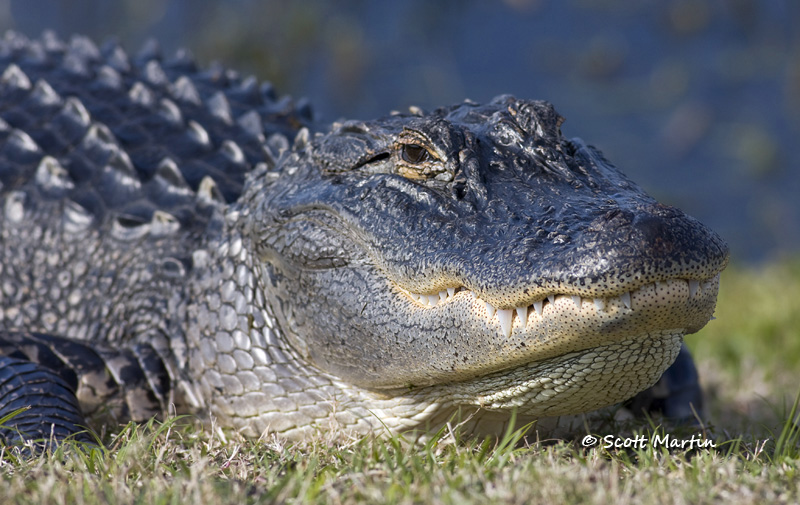
Make sure the next time you are in Florida you include a trip to the Viera Wetlands. You will be glad you did.
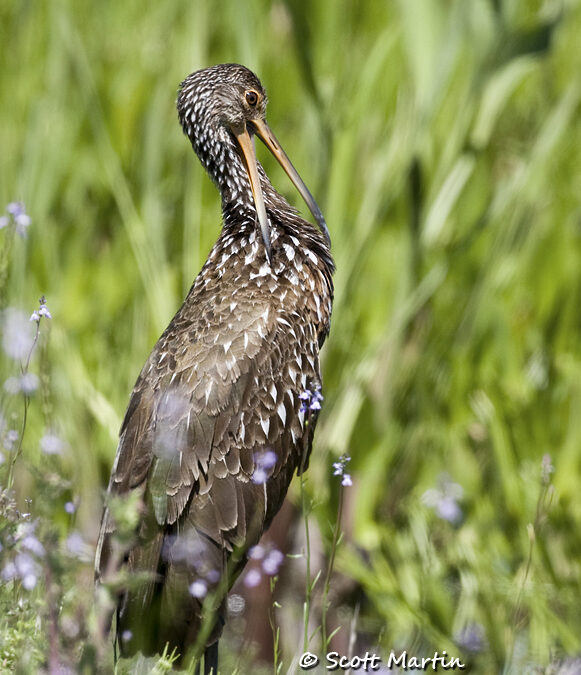
by Scott Martin Photography | Apr 16, 2011 | Birds, Blog, Shore Birds & Waterfowl
The Limpkin is a very unique bird and one of my favourites to photograph whenever in Florida. They are a large bird, 26-28 inches in length with a wing span of approximately 45 inches. Although morphologically they look like large Rails and skeletally they resemble Cranes, by design they are perfect for what they do, which is forage for Apple Snails – their primary diet. The Limpkin gets its name from its rather awkward appearance whether in the air with its stilting wing movement or walking along the ground with its less than smooth gait. Not surprisingly, a collective group of Limpkins is known as a “hobbling”. The world-wide population of the Limpkin is strong with numbers estimated at over 1,000,000 mostly in South and Central America. In Florida its numbers are on the decline due to the declining Apple Snail population created by urbanization. As a result the Limpkin is listed as a “Species of Special Concern” in North America.
This first image of a Limpkin is somewhat of an attempt to give the shot an artistic feel by purposely moving to have the purple flowers in front of the bird in the foreground…..not sure if it works, but it’s always a good exercise to experiment with composition whenever you have your camera out!
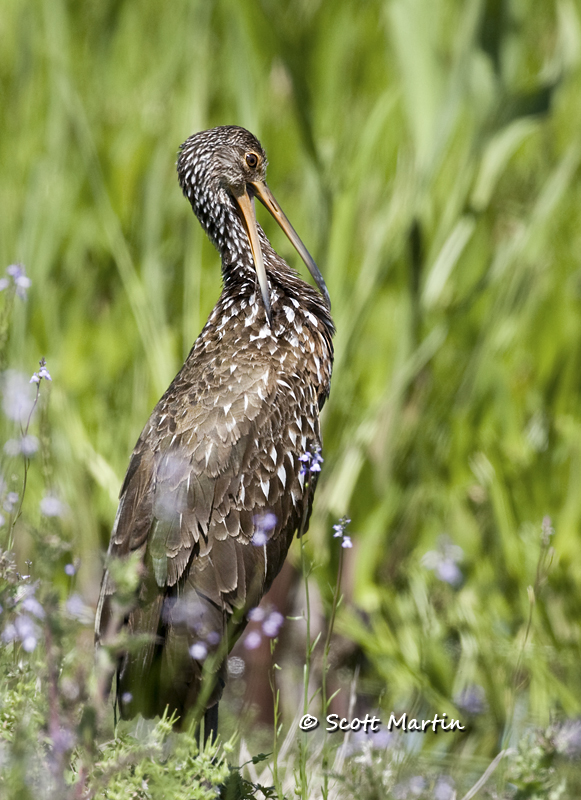
The following image shows the strong and powerful beak of the Limpkin. After finding an Apple Snail the bird places it on the ground, carefully lines it up and then impales the shell with its beak so it can then extract the snail. The design of the beak is perfect for doing this. It is a very interesting feat to observe and also hear the unique sound it makes.
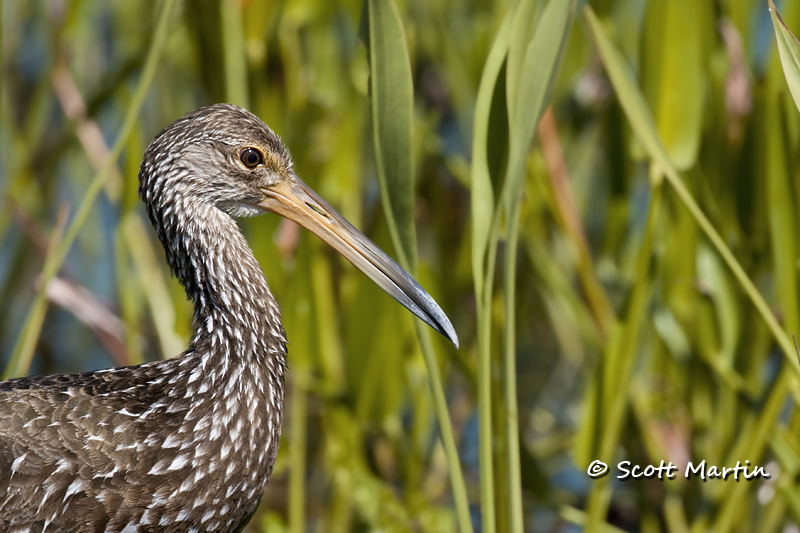
Happily bringing another Apple Snail to the waters edge for a snack.
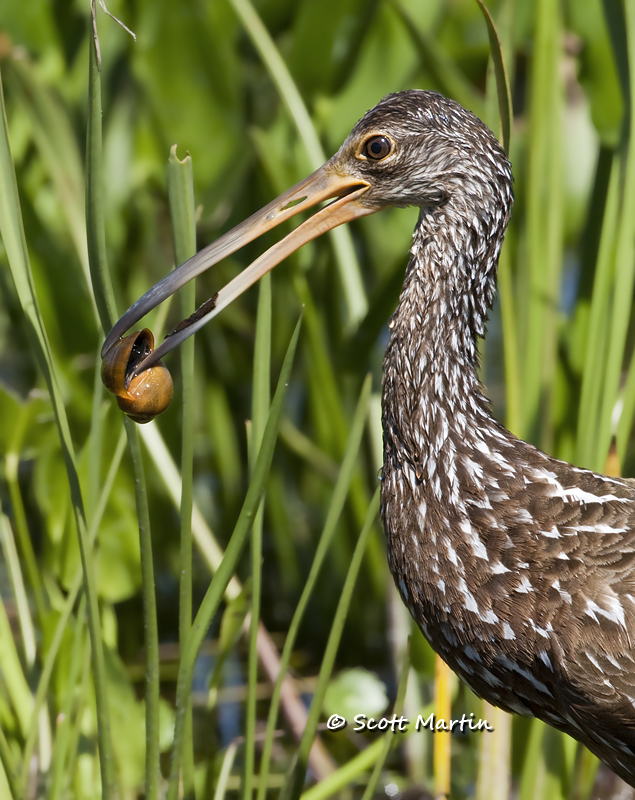
There are many more Limpkin images, including a number of in flight shots you can see in the Wading & Shore Birds Gallery
More Limpkin Images
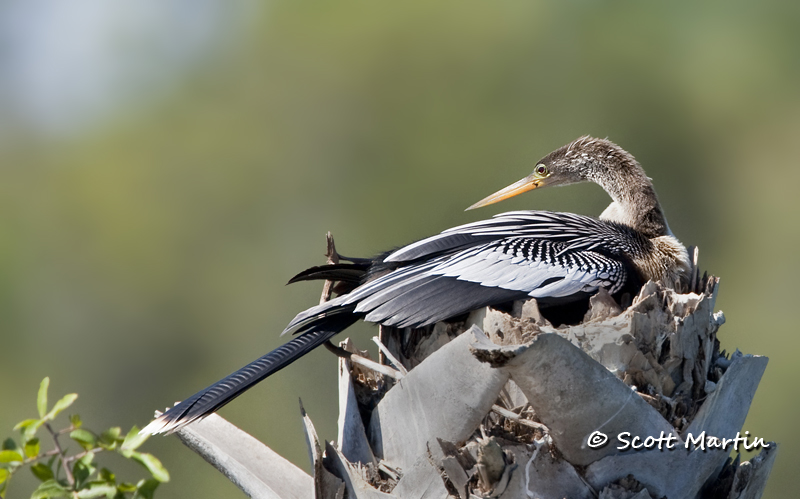
by Scott Martin Photography | Apr 14, 2011 | Birds, Blog, Shore Birds & Waterfowl
The Anhinga is a large water bird that is found around the world and is common in Florida, where all of the images in this post were taken. The Anhinga is an unusual bird with a long snake-like neck and a large tail that resembles that of a wild turkey which has resulted in the nick name “Water Turkey”. Anhingas are about three feet long with wing spans of approximately four feet. Like their cousin the Cormorants, they lack the ability to secrete oil onto their feathers in order to waterproof them. As a result they are less buoyant and very capable swimmers traveling deep under the surface to spear fish with their long sharp beak. Anhingas often paddle along the surface with only their neck and head above the water which is interesting to observe. The fact that their feathers are not waterproofed requires the Anhinga to dry off its feathers and wings before being able to fly. They do this by spreading their wings in the sun at the water’s edge or in nearby thickets.
Anhinga on the nest.

Although Anhingas are typically quiet, they will get quite vocal when challenged by other birds or predators. The next image also shows the tail display, quite similar to that of a wild turkey.
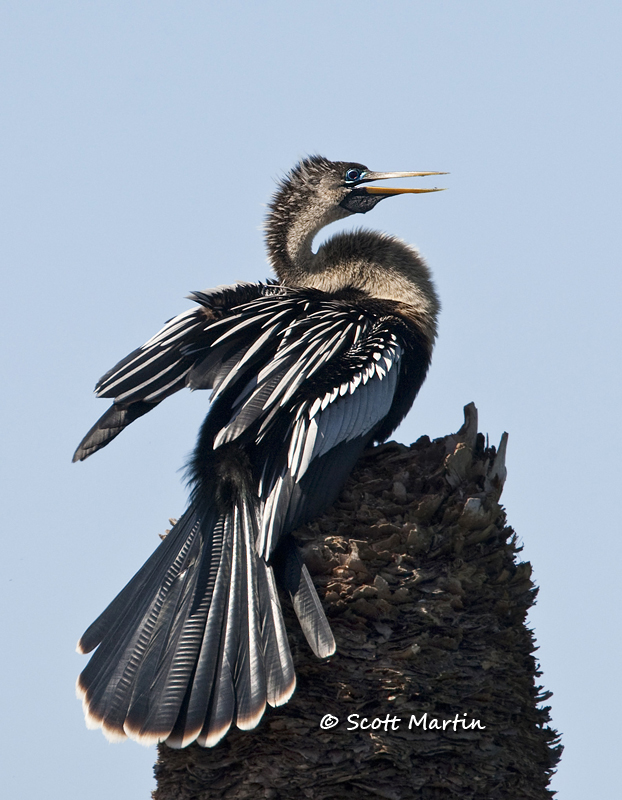
.
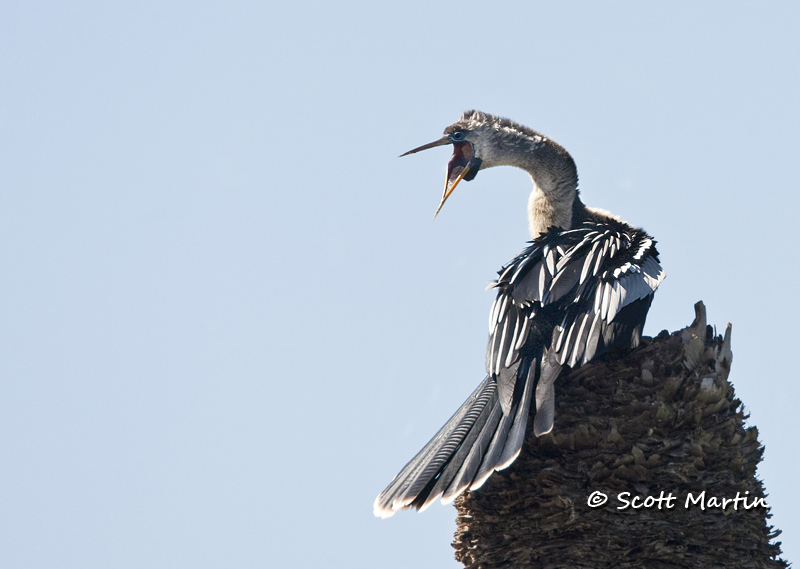
The classic swimming posture with the body completely submerged.
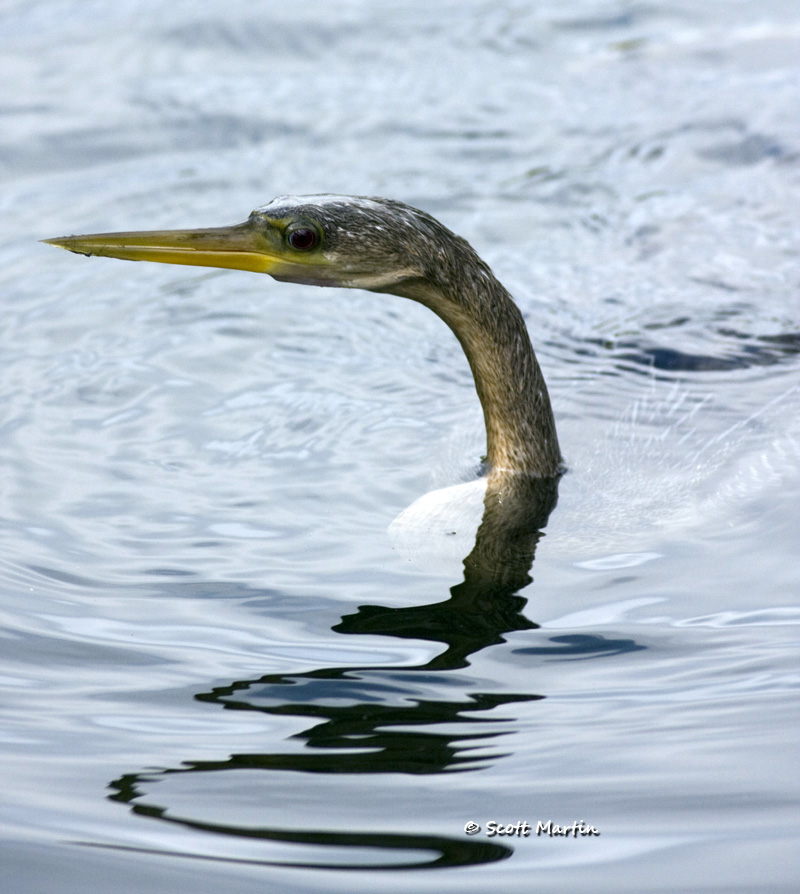
More images of Anhingas can be seen in the Pelicans, Anhingas and Cormorants Gallery
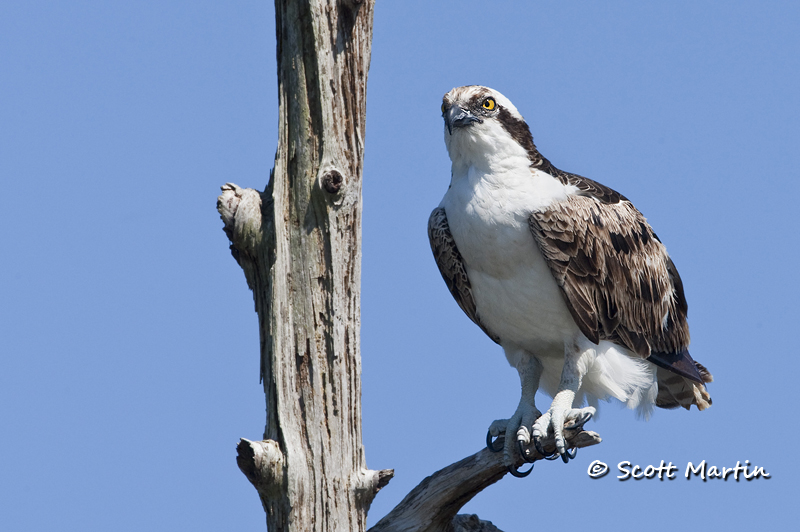
by Scott Martin Photography | Apr 12, 2011 | Birds, Blog, Raptors
The last blog entry concentrated on in-flight images of Osprey. It is very difficult to plan for in-flight shots although knowing the behaviour of the bird you are shooting does help in selecting the best vantage point to provide an increased likelihood of getting that perfect shot. Today’s post concentrates on a perched Osprey and a most fortunate situation where the bird remained on the perch for about ten minutes allowing time to set up for different shots and think about composition as well as positioning for the best light. All of the images today were shot using the EF 500mm f/4 L IS lens with a Canon 1.4x TC creating a focal length of 700mm. These shots were taken using a monopod as I didn’t want to risk setting up the tripod and have the bird leave his perch before I was set up…..an unfortunate occurrence that virtually every bird photographer has experienced at least one too many times!
These images are helped by a great perch that itself is visually interesting, a beautiful blue sky and a healthy Osprey who was perched only twelve feet above the surface of the water at the Viera Wetlands on the East coast of Florida.
This first image is a bit awkward compositionally as the free space required on the left (providing space for the bird to look into) positions the perch too centrally in the image for my liking and the angle to the sun leaves fairly large shadows across the neck and chest of the bird.

The next two images were taken from the same position however the ‘over the shoulder’ pose of the Osprey allows for free space to be placed on the right side of the image, moving the perch to a position that is much more appealing than in the first image. This results in the second & third images being much better photographs than the first. The third image was ‘warmed’ a little in post processing by increasing the white balance temperature about three hundred degrees. Adjusting the white balance in post processing can create subtle to rather dramatic changes in the final image, which is one of the many reasons to always shoot in RAW format where exposure and white balance can be adjusted in post processing. Neither of these two parameters can be changed if you shoot in JPEG format.
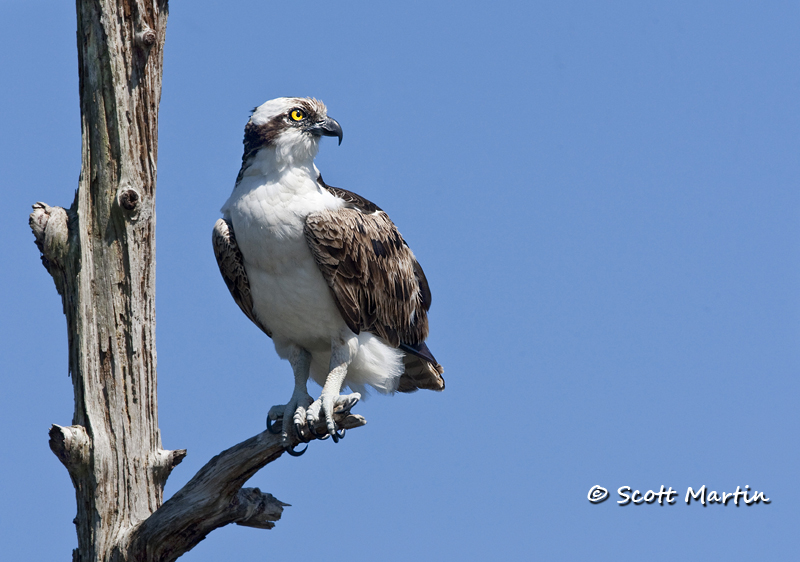
.
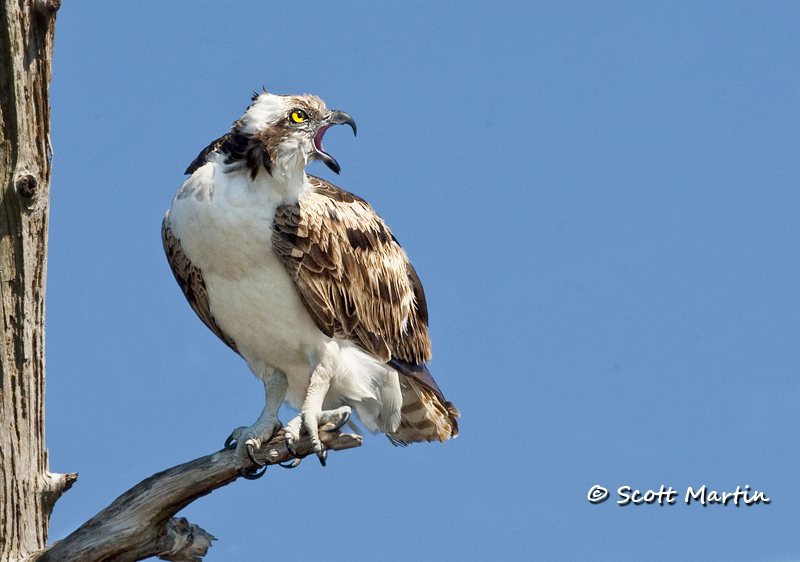
The position for the next image was changed in order to minimize the shadow across the neck of the bird, however doing this moved the perch directly behind the body of the bird, which should generally be avoided. Cropping the image vertically and keeping the perch out of the centre of the frame helps improve the composition. Shooting birds and landscapes in a portrait orientation is not often suggested, however often works well. When Bryan Peterson was asked when to shoot in a vertical format, his answer was “only after you’ve already taken the shot in a horizontal or landscape format”. This is good advice so after you’ve got all the shots you want in the landscape perspective, don’t forget to turn your camera ninety degrees and take a few more shots.
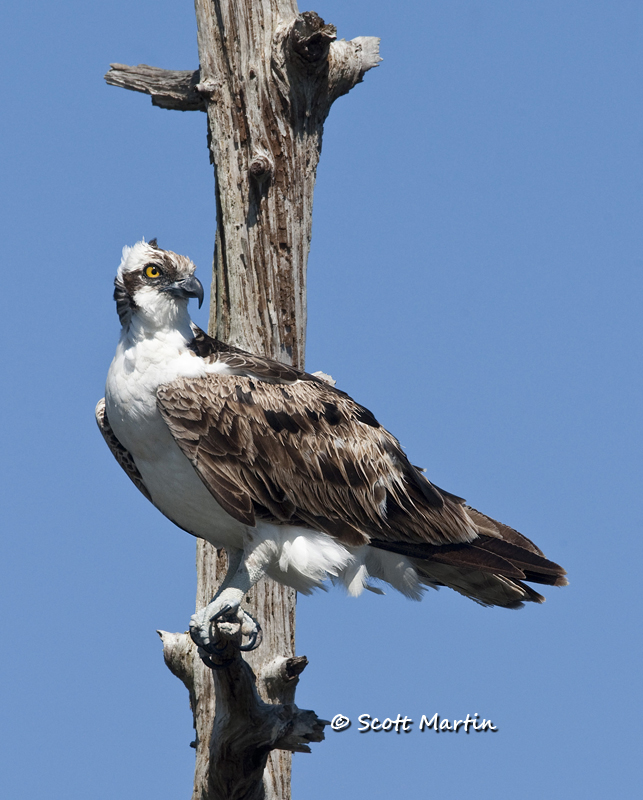
After posing wonderfully for about ten minutes it was time to head off and find another fish.
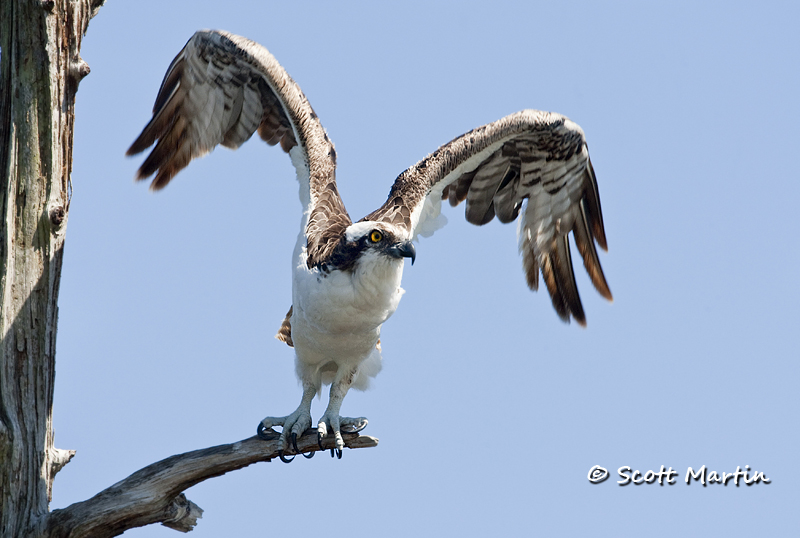
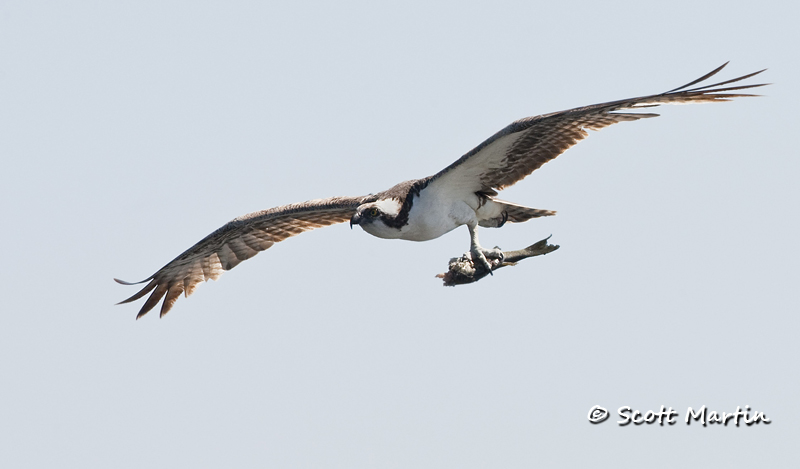
by Scott Martin Photography | Apr 10, 2011 | Birds, Blog, Raptors
Its been a whirlwind of activity around our place over the past month, so there has not been much time to process images and write blog posts, however it looks like things will be settling down a little and I can post some new images over the next few weeks.
Although Osprey used to be known as “Fish Hawks”, they should more accurately be known as “Salt or Sea Eagles” based on their scientific name, Pandion haliaetus (Greek ‘hal’ = salt or see; ‘aetos’ = eagle). The Osprey is the only raptor that feeds exclusively on live fish, which they catch by plunging into the water talons first, with such a force that they often completely submerge before coming up with a fish.
When Osprey fly while carrying a fish they always rotate the fish so it faces head first providing better aerodynamics as can be seen in these first two images.

.
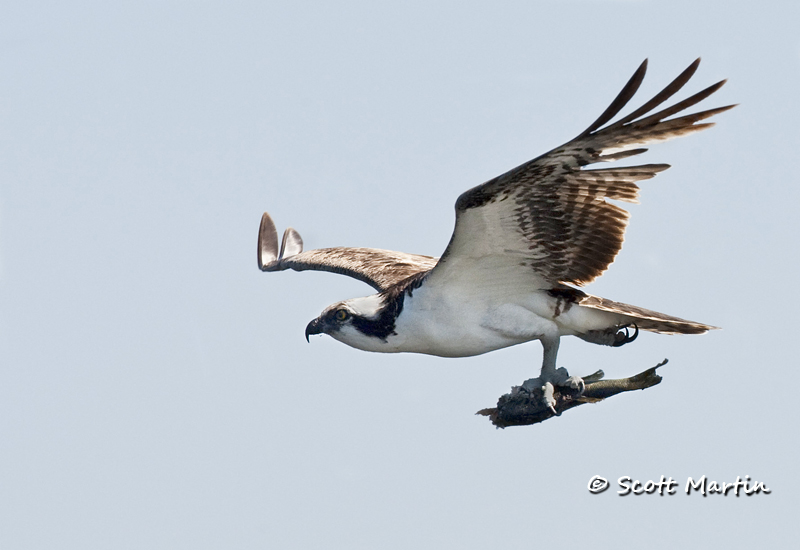
This is the same Osprey perched and ready for his meal, however I don’t think he liked having the camera pointed at him.

The previous three images were shot at the Viera Wetlands which are on the Atlantic Coast of Florida not too far south of Cape Canaveral and Cocoa Beach. The next image was taken at the Sebastian Inlet Nature & Wildlife Preserve which is located about an hour south of the Viera Wetlands. It’s not a great image however I like the way the strong back lighting illuminates the wings.
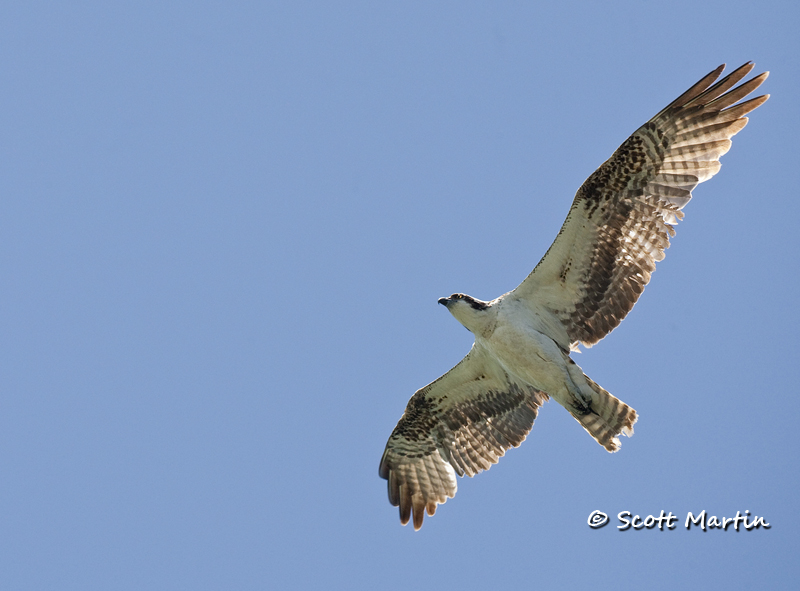
The next in flight image was taken from a boat we chartered in Lake Toho in order to photograph Snail Kites (which will be posted soon). Lake Toho is near Kissimmee in Central Florida.
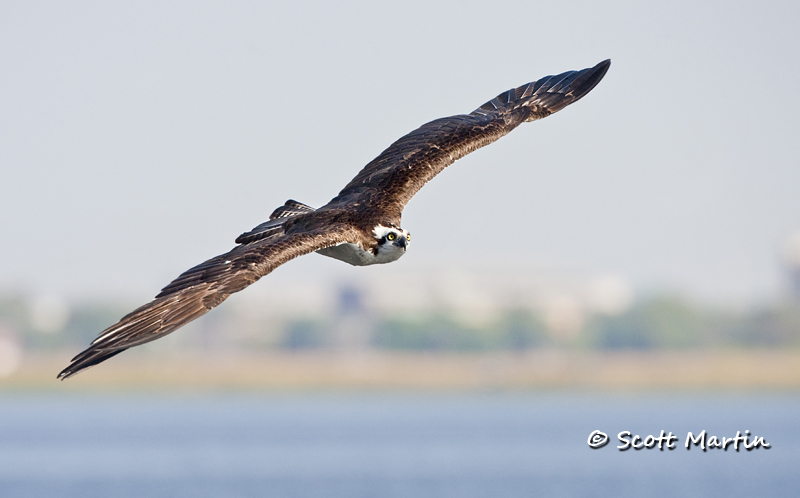
The last image for this blog post shows a female Osprey incubating her eggs which is a job shared by both parents. Osprey build large nests which they continue to construct over the years until they become quite huge. They are often built on platforms placed on telephone poles along highways in the south. In this case they were nesting on top of a wooden pole out in Lake Toho about ten feet above the lake surface.
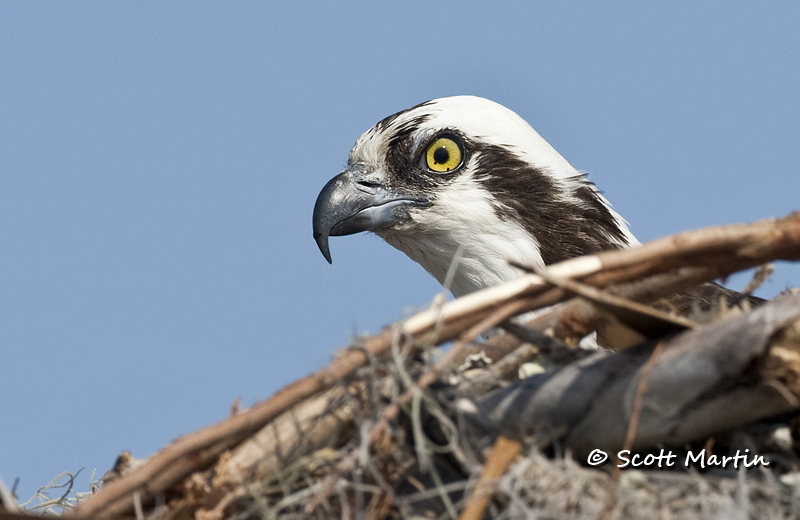
I’ll post part two of the Osprey photographs in the next couple of days.










































Follow Scott Martin Photography